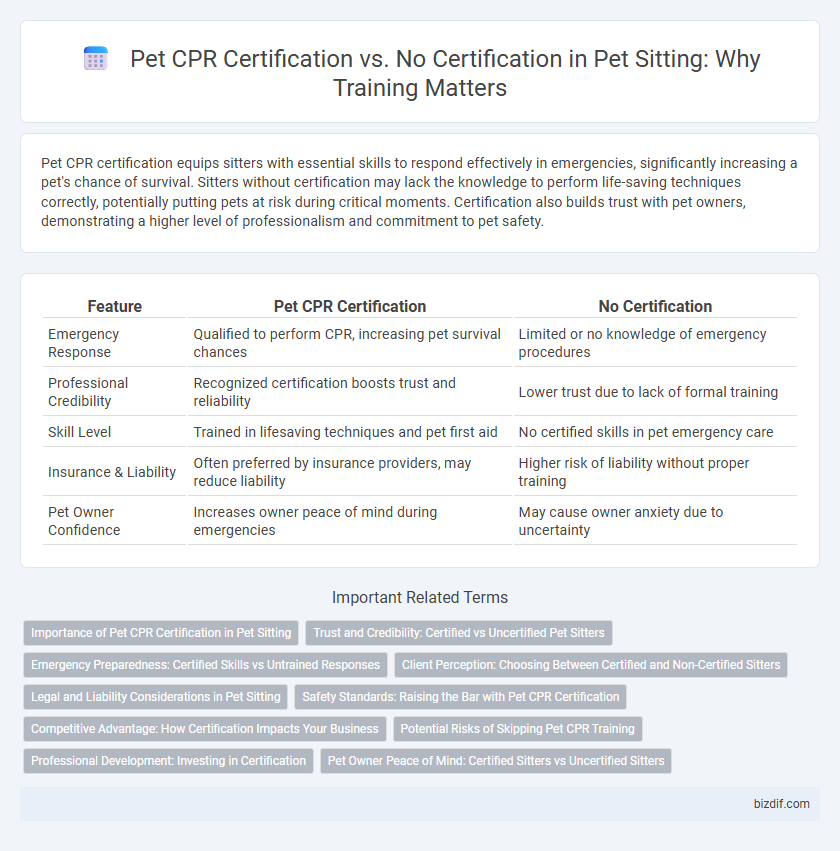Pet CPR certification equips sitters with essential skills to respond effectively in emergencies, significantly increasing a pet's chance of survival. Sitters without certification may lack the knowledge to perform life-saving techniques correctly, potentially putting pets at risk during critical moments. Certification also builds trust with pet owners, demonstrating a higher level of professionalism and commitment to pet safety.
Table of Comparison
| Feature | Pet CPR Certification | No Certification |
|---|---|---|
| Emergency Response | Qualified to perform CPR, increasing pet survival chances | Limited or no knowledge of emergency procedures |
| Professional Credibility | Recognized certification boosts trust and reliability | Lower trust due to lack of formal training |
| Skill Level | Trained in lifesaving techniques and pet first aid | No certified skills in pet emergency care |
| Insurance & Liability | Often preferred by insurance providers, may reduce liability | Higher risk of liability without proper training |
| Pet Owner Confidence | Increases owner peace of mind during emergencies | May cause owner anxiety due to uncertainty |
Importance of Pet CPR Certification in Pet Sitting
Pet CPR certification equips pet sitters with critical skills to respond effectively during emergencies, significantly increasing the chances of pet survival and recovery. Certified sitters demonstrate a higher level of professionalism and trustworthiness, reassuring pet owners that their pets are in capable hands. Without certification, sitters may lack the essential knowledge and confidence to perform life-saving procedures, potentially risking the pet's health in urgent situations.
Trust and Credibility: Certified vs Uncertified Pet Sitters
Pet sitters with CPR certification demonstrate higher trustworthiness and professional credibility, reassuring pet owners of their ability to handle emergencies effectively. Uncertified sitters may lack essential life-saving skills, raising concerns about pet safety during critical incidents. Certification in Pet CPR serves as a reliable indicator of competence, significantly enhancing client confidence and peace of mind.
Emergency Preparedness: Certified Skills vs Untrained Responses
Pet CPR certification equips sitters with critical skills to effectively respond during emergencies, significantly increasing a pet's survival chances through trained procedures like chest compressions and rescue breathing. Untrained pet sitters often rely on guesswork, which can delay life-saving action and reduce the likelihood of positive outcomes in cardiac or respiratory crises. Certified emergency preparedness ensures prompt, knowledgeable intervention, providing peace of mind to pet owners and prioritizing the animal's wellbeing.
Client Perception: Choosing Between Certified and Non-Certified Sitters
Pet CPR certification significantly enhances client trust by demonstrating a sitter's preparedness for emergency situations, increasing perceived professionalism and reliability. Non-certified pet sitters may face skepticism regarding their ability to handle critical incidents, potentially reducing client confidence and preference. Certified sitters often attract more clients willing to invest in comprehensive care, reflecting higher marketability and competitive advantage.
Legal and Liability Considerations in Pet Sitting
Pet CPR certification significantly reduces legal risks and liability exposure for pet sitters by demonstrating verified skills in emergency pet care, which can be crucial in court or insurance claims. Without certification, pet sitters may face increased liability as they lack documented proficiency to legally defend their actions during a pet emergency. Certified pet sitters often benefit from enhanced credibility and eligibility for insurance coverage, mitigating potential financial and legal repercussions related to pet injuries or fatalities.
Safety Standards: Raising the Bar with Pet CPR Certification
Pet CPR certification significantly enhances safety standards by equipping pet sitters with essential life-saving skills not covered in untrained care. Certified individuals demonstrate proficiency in emergency response techniques tailored to pets, reducing the risk of complications during critical situations. Incorporating Pet CPR certification into pet sitting protocols raises the overall quality of care, ensuring pets receive immediate and effective assistance when needed.
Competitive Advantage: How Certification Impacts Your Business
Obtaining Pet CPR certification enhances your credibility and builds trust with pet owners, directly increasing client acquisition and retention. Certified sitters demonstrate a higher level of preparedness and professionalism, setting them apart from competitors without formal training. This competitive advantage often translates into premium pricing opportunities and stronger business growth in the pet care industry.
Potential Risks of Skipping Pet CPR Training
Skipping pet CPR training significantly increases the risk of improper emergency response, which can worsen a pet's condition or lead to irreversible damage during cardiac arrest or choking incidents. Certified pet sitters possess critical skills to perform effective chest compressions and rescue breaths, improving survival rates and reducing complications. Without certification, untrained individuals may delay necessary care, causing potentially fatal outcomes and exposing pet owners to liability concerns.
Professional Development: Investing in Certification
Investing in Pet CPR certification enhances professional development by equipping pet sitters with vital emergency response skills that increase client trust and safety. Certified pet sitters demonstrate commitment to high standards of care, distinguishing themselves from uncertified professionals in a competitive market. This certification improves job prospects and confidence in handling critical pet health situations effectively.
Pet Owner Peace of Mind: Certified Sitters vs Uncertified Sitters
Pet CPR certification empowers pet sitters with critical lifesaving skills, providing pet owners with increased confidence and peace of mind during care. Certified sitters are trained to respond effectively in emergencies, reducing risks and enhancing overall pet safety. In contrast, uncertified sitters may lack the knowledge to handle urgent situations, causing potential stress and uncertainty for pet owners.
Pet CPR certification vs No certification Infographic

 bizdif.com
bizdif.com